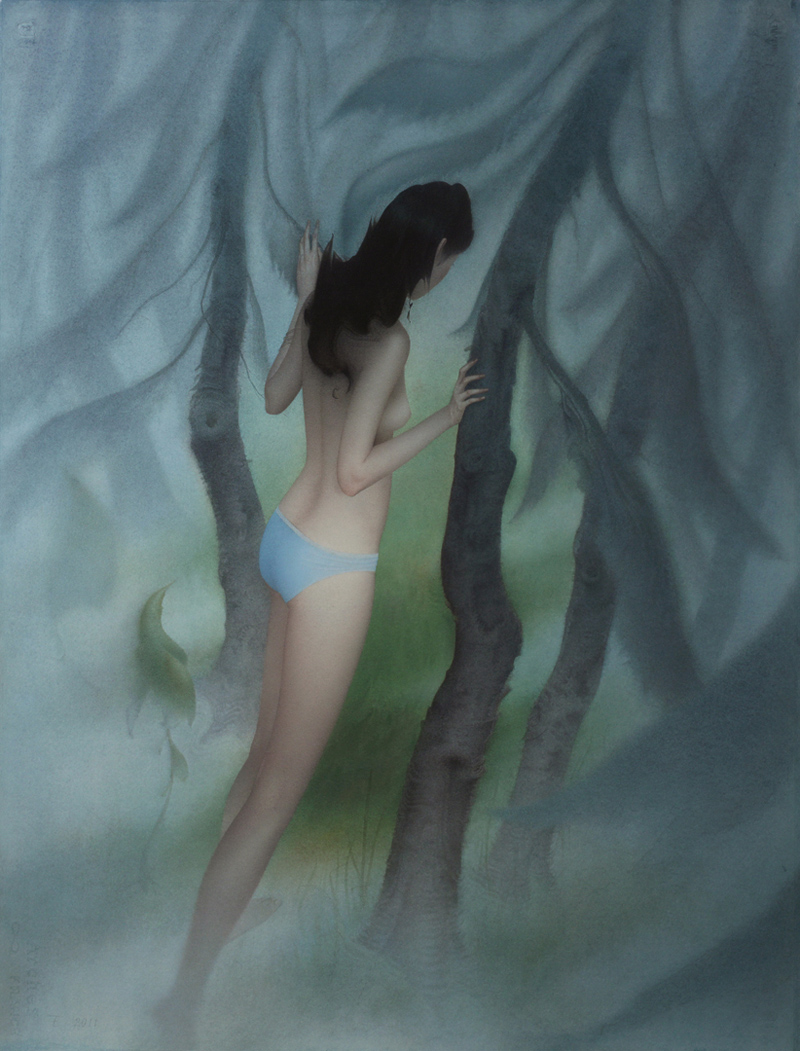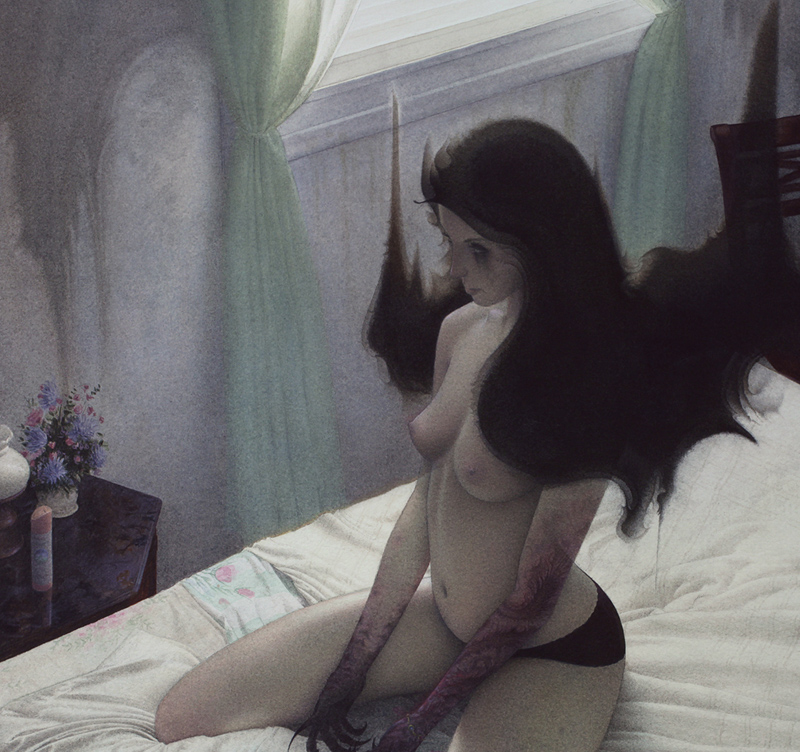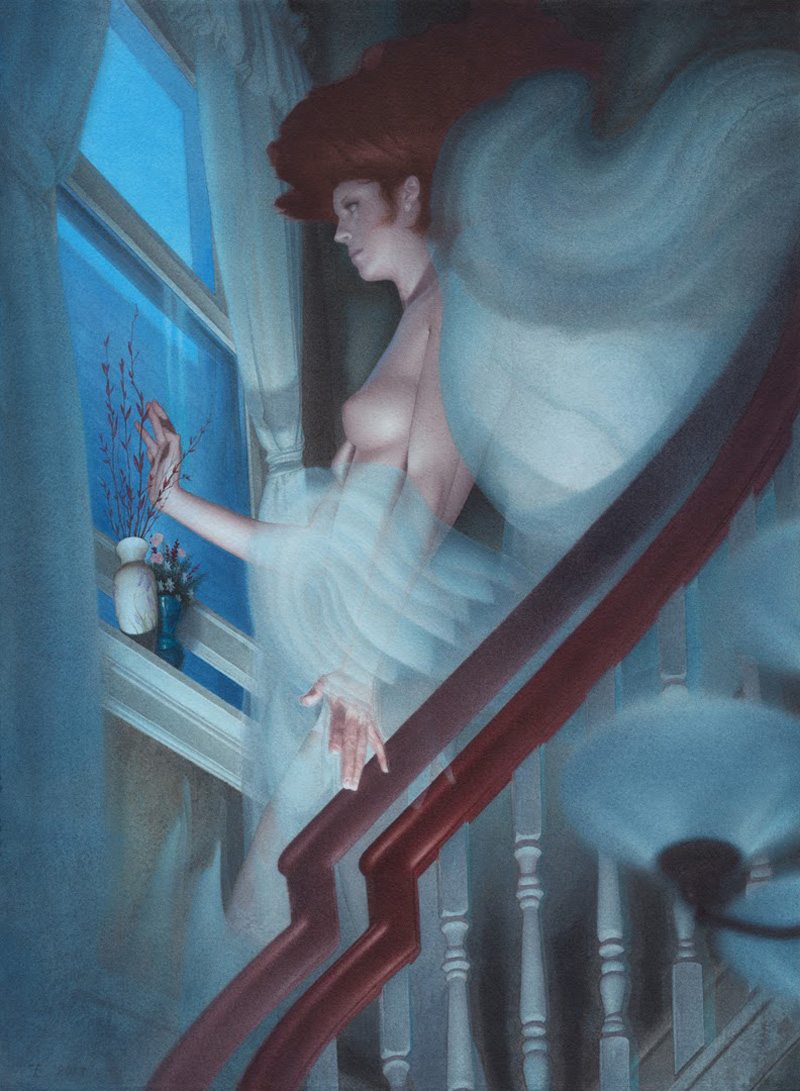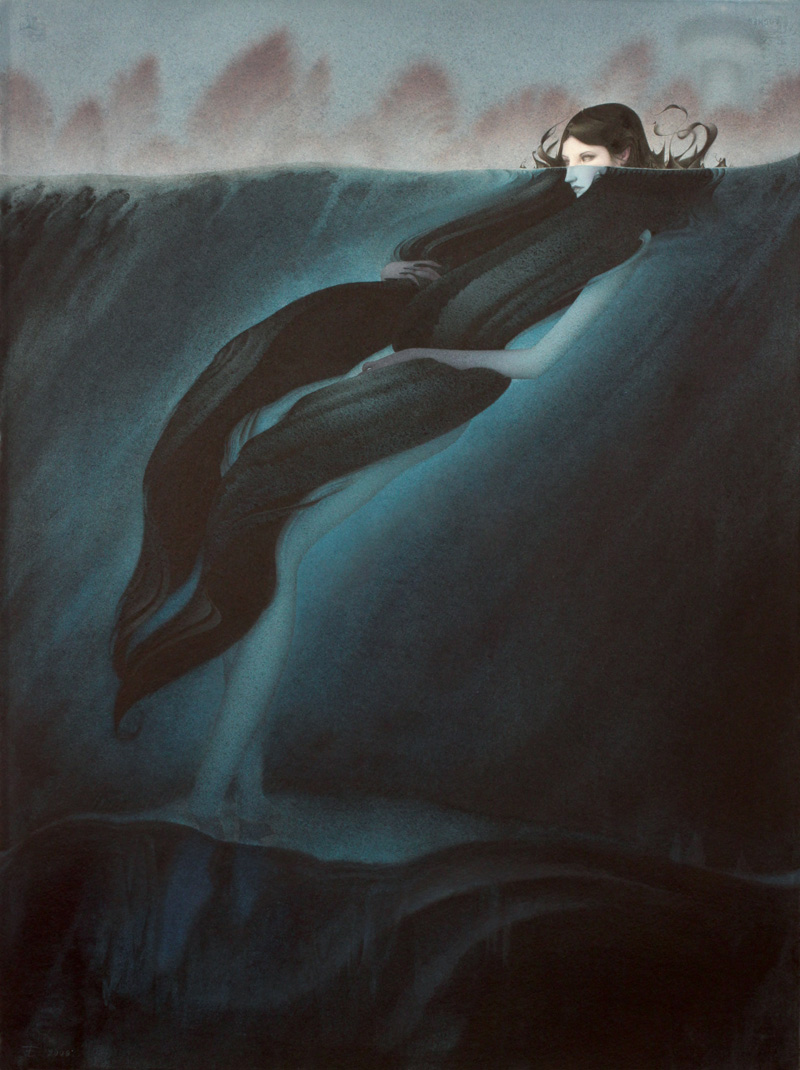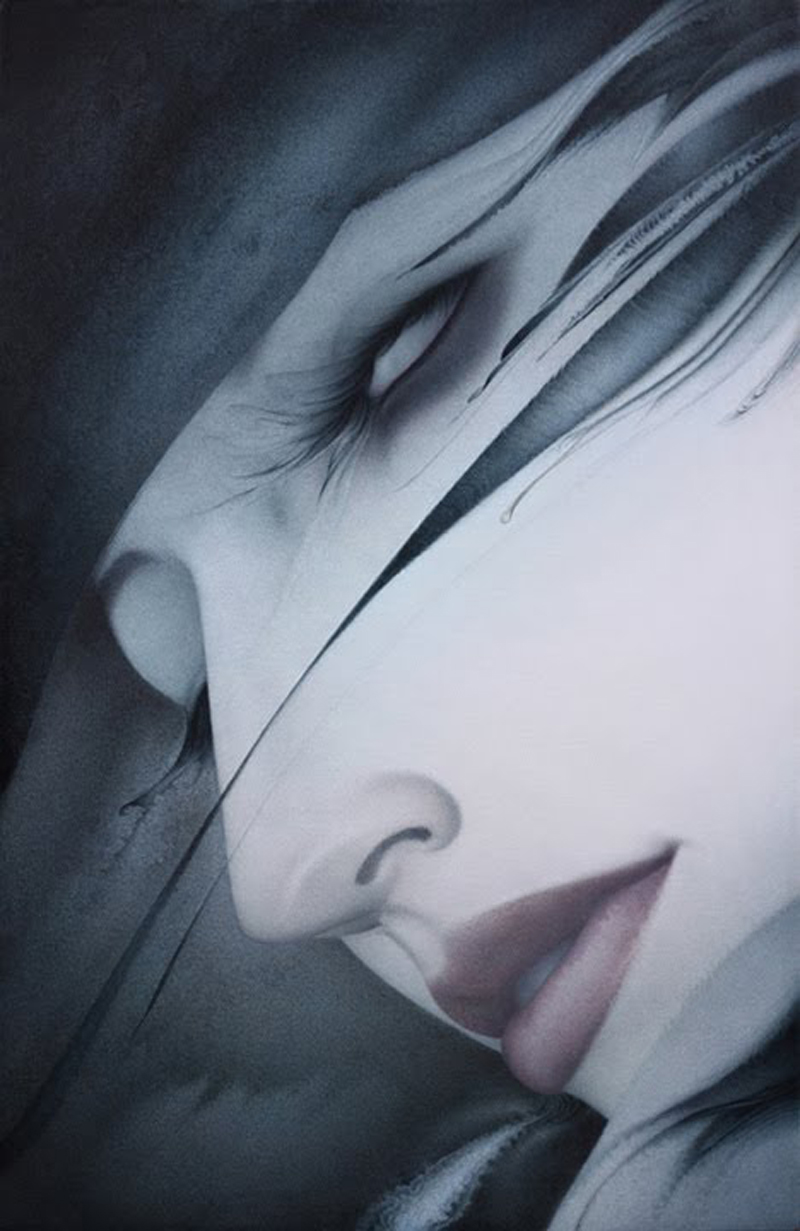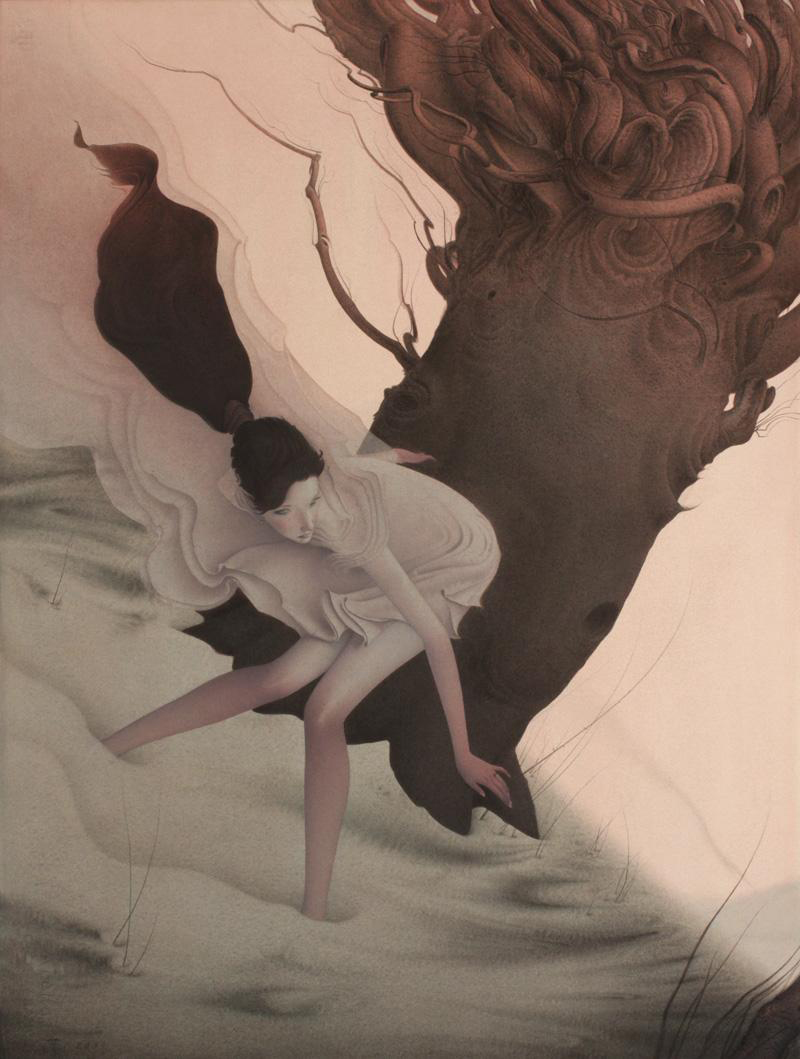With Baby Tattooville coming up in a couple weeks (see associated museum show), we’ll be bringing you some interviews with the participating artists. First up is another Q&A session (see 2009) between AM and Eric Fortune.
Severe angles contrasted by a hazy atmosphere are the hallmarks of the Columbus, Ohio based artist’s work. He was recently featured on the cover of Hi-Fructose, and he is coming off recent shows at Copro Gallery, Gallery Nucleus and Roq La Rue. Check out the full interview below, but be forewarned, it didn’t take long for the conversation to turn to Neil Degrasse Tyson, penis drawings and an unpaid debt from Dan dos Santos.
AM: Can you tell me what a typical day is like for you in Columbus?
EF: My typical day is rather uneventful. I’ve been really burned out on painting the past few years and not making as many paintings. So, my efforts have been leaning towards educating myself with whatever seems interesting at the time. The things I learn tend to slowly leak into my personal work. I find topics like Ray Kurzweil’s technological singularity fascinating and often wonder how such new technologies could make for a better world. I don’t just mean better in the sense that the internet is faster, we have new tech toys like the pulsating flesh light 17.0 molded after your favorite porn star and 3D printed using her actual cells etc. Don’t get me wrong that stuff sounds cool but what about the really big challenges that humanity has: How can we end poverty forever? Can we overcome scarcity and inequality? Can we organize an automated society where jobs become obsolete so people can focus their energy on more meaningful work, perhaps something like making art? If production becomes so efficient and ubiquitous will the need for money or exchange become necessary at all? Can we outgrow the need for money? hat’s a crazy question, but a notion that seems almost inevitable if one considers the exponential growth of technologies. I spend a lot of time reading and learning about these concepts. What would it be like to be an artist in a post scarcity society? Letting all the technology do our drudge work while humans are freed to pursue their dreams, how amazing would that be? How many unrealized Michelangelo’s are out there wasting their lives away right now? And of course, what new problems would arise? But as I mentioned, I’m not creating as much art as I used to. However, I feel the work I am producing has deeper meaning and is more relevant than it used to be. I don’t always know how the work is interpreted by others. I guess part of that is out of my hands.
Other than that, I have been spending more time with my family. Thinking about the future is necessary in my opinion, but at some point I need to be here in the now to enjoy what I have. None of this may come to pass in my lifetime. Humans have been pretty good at messing shit up so far.
AM: When reading descriptions of your paintings the word “haunting” comes up over and over. Is there a supernatural element to your art? Do you believe in ghosts?
EF: I used to believe in ghosts. I was raised Catholic and I was scared of the dark for most of my life. I blame The Exorcist. That movie ruined my damn life. I don’t even watch scary movies anymore. All the lights would stay on for at least a week.
However, things have changed a lot in the past several years. One of my recent pieces, The Demon Haunted World (seen above), does indeed appear to show a demonic figure sitting on a bed. You can’t really see it in the online images but she’s holding a rosary. For anyone who has experienced sleep paralysis this may be familiar, the sense that something is present in the room, something beyond this world and beyond our understanding, not being able to move or scream, just rolling your eyes around and panic. Many cultures have stories that went along with this phenomenon, stories that involved the supernatural. Over time, these stories fade away as we learn more and more about how our world works and how our brains work. The Demon Haunted World is a tribute to Carl Sagan who wrote a book of the same name. Like Neil Degrasse Tyson, Sagan is a great communicator of science and has had such an amazing influence on me. I wish I had known of him while he was alive. I would probably have written him an email and thanked him or sent him a print. If you haven’t seen, “Cosmos” with Carl Sagan or the new season with Neil Degrasse Tyson you’re really missing out.
AM: Can you tell me how creating your art feels, ie is it therapeutic, do you have to suffer for art, draining, energizing, uplifting, scary, fun? How do you know when a piece is finished, and how does it feel when you realize that a particular work is completed?
EF: I feel all of these things, at times I’m immersed in making the art, in the zone. That is the absolute best. Unfortunately, these moments are more and more seldom. I think part of it has to do with my trying to learn other non-art related stuff at the same time that I paint. We all seem to think we’re pretty good at multitasking. As I understand it, we actually kind of suck at it and both tasks suffer. My art takes longer than it used to because of this and I’m easily distracted, wanting to take notes or comment on some YouTube lecture.
In general, I noticed that my work is more enjoyable during the 10% at the beginning and the 10% at the end when I’m just tweaking little details. The 80% in the middle is a slow grind and I wish I had a clone to do that part of it. It does feel really good to complete a new piece though. I get excited as I’m about to sign the painting. Yet, almost every time something flips in my head just after I finish the last brush stroke and I feel like I could’ve done better. Though given a month or so of not staring at it all day, I usually feel pretty good about most of my paintings.
AM: Your art is extremely serious, with a tremendous amount of technical detail and thought provoking themes. Is there a lighter side of Eric Fortune (do you ever doodle race cars or dinosaurs)?
EF: I think it would be funny to have testimonials from some of my art friends or people I’ve met at conventions here. You’d probably hear two things: 1) Eric has dick jokes. They’re not all good dick jokes. 2) Eric draws the most beautiful penises I’ve ever seen. And he’s extremely efficient at it.
I have a lot of practice but I’m better with my right hand than my left. Sometimes I sit on my drawing hand until it gets numb then I try to draw with it. I call it “The Stranger”. It feels like I’m at a convention already. A few drinks and some sketch paper and it is on.
I also have a pop up penis card that I make as a gift to friends. I think it’s pretty awesome. I’ll have to send you some pics or maybe a video. I know you’re dying to see it. I really appreciate this question. Life is often too serious.
AM: Your work involves a complicated, multi step process of photos (that I believe you usually take yourself), illustration and watercolor painting to get to the final product. Did you learn this method from someone, or did you come up with it yourself? Have you always created this way? (Was there trial and error involved)?
EF: I did not come up with this method. I actually had to unlearn thinking that working from photo reference was cheating. It’s such a juvenile thought. If I had photographic memory I wouldn’t need to take photo reference. I do not have a photographic memory and I don’t have professional models that hold poses for hours and follow me everywhere I go so that I can refer to their anatomy etc. If I did, I probably wouldn’t be an artist. My resume would read something like, “Occupation: Peeyimp”. I learned using photo reference from my teachers at the Columbus College of Art and Design. Previously, I had prided myself at not having to use photo ref. Not having to use photo ref and thinking photo ref is a bad thing are not the same thing. For my work, it’s about finding a balance between my loose sketches and the photo ref to try and produce a believable, cohesive image. That balance will be different with everyone. There’s no wrong way to make art. I think in some ways it kind of depends on the intent. If, as an artist, you’re leaning towards presenting a more realistic finish, then I would say, definitely use photo reference, but take your own photos for as much as possible. Depending on other people’s photos that you can find online or in a magazine etc are very limiting to your creativity. Get your friend, dress them up, dress them down, light them however you want to and take your own pictures. Taking control of this information can really boost the quality of your work. Just remember you’re referring to your reference not copying it. Don’t let your personal style become a slave to the reference.
AM: Have you ever traded art with another artist?
EF: Swapping art is one of the perks of being an artist. I don’t do it often. Much of my work is unavailable. My good friend and fellow artist Dan Dos Santos has one of my favorite pieces Stephanie Shrugs. We made half a trade a while back. Still waiting Dan… 😉
AM: Have you ever collaborated with another artist, or is there a dream collaboration you would like to have happen?
EF: I haven’t collaborated with anyone yet. I do plan on collaborating with Brian Ewing and possibly Andrew Bawidamann in the near future. We’re all featured in the art documentary Making It and we plan on producing an image for the cover that will also be released in a limited edition print. Stay tuned for more.
Dream collabo? That would probably be with a favorite scientist, author, or researcher. Not quite sure how that would work out.
AM: Is this your first time at Baby Tattooville? Are there any artists you are excited to meet that will be at Baby Tattooville (and what would like to talk with them about)?
EF: This is my first time there. I’m a huge fan of Brom. He and his wife Laurie make beautiful paintings. I’ve met him a few times at conventions. He’s the nicest guy. He was also interviewed in the Making It documentary and he said something that really connected with me. Something about being in his mid 30’s and feeling really burned out and needing to try something different with his creativity. I totally feel that. I’m hopeful that after a little break from art I can feel rejuvenated, but I’m not sure in what direction that may take me.
AM: Do you know the people that you paint? Does their personality come out in the work?
EF: I do know my models, they are usually friends and family. I don’t really think their personalities come out in my work. I need information about lighting, anatomy, folds and drapery etc. I apply the context of the image around the figure. I manipulate it enough so that it’s saying what I want it to say. Everyone is different and I appreciate what each has to offer as a model.
AM: Can you tell me the story of when you found out your art would be on the cover of Hi-Fructose? (where were you, did you know you would be in the issue before you found out you had the cover, did you find out via email, phone call, etc.).
EF: I actually like this story. As usual, I’m in my studio when I receive an email from the very nice people at Hi-Fructose asking if I’d like to be interviewed again for the magazine. My response went something like this, “Well, let me check my schedule, hmm… I see…OF COURSE!!!” Obviously, it’s a huge honor to be featured in Hi-Fructose. After completing the interview and sending in my images, I was asked if I minded that they used one of my images as the cover. My response was something like, “Well, I don’t know, what are….OF COURSE!!!” Not to sound like a shitty art dad, but it’s one of my favorite pieces, The Goddess of Antiquity, (seen at the top) originally shown at Roq La Rue Gallery. Being featured on the cover is a definite career highlight for me. My mom likes to show it to everyone, so that’s nice too.
Discuss Eric Fortune here.




